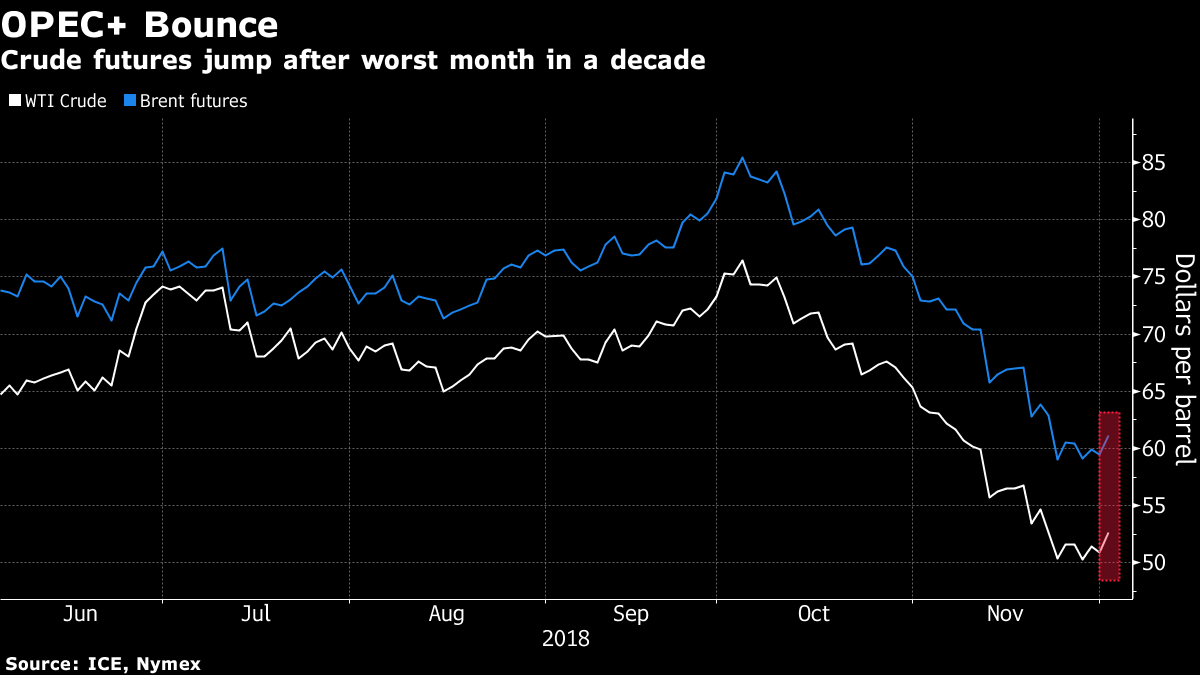Dec 2, 2018
Oil jumps most since June, WCS rallies over 50% on Canada cuts
, Bloomberg News

Oil surged the most in more than five months as Saudi Arabia and Russia extended a cooperation pact and U.S.-China trade tensions cooled. Unprecedented supply cuts in Canada also drove prices higher.
Futures in New York advanced almost 6 per cent on Monday, bouncing back from the worst monthly slump in a decade. Although Russia and Saudi Arabia have yet to confirm any fresh cuts, their agreement opened the door for a deal when OPEC meets this week in Vienna.
Friday’s high-five between Saudi Crown Prince Mohammed bin Salman and Russian President Vladimir Putin at the G20 summit in Argentina began a weekend of bullish developments for oil markets. Prices had plunged over the past two months on fears of a global oversupply, capped by a 22 per cent slide in November.
“These are the positive pronouncements that the markets have been waiting for,” said Ashley Petersen, an oil analyst at Stratas Advisors LLC in New York. “Now that we’re here, we should see a big price correction going through the end of this week. The big question is, will OPEC follow through?”
Oil pared gains during Monday’s session after a key OPEC advisory panel was said to make no recommendation for action on supplies ahead of the broader cartel’s gathering.

President Donald Trump and his Chinese counterpart Xi Jinping called a pause in their trade dispute after a dinner at the G20 event. The U.S. agreed to postpone a planned tariff hike on Chinese goods for three months in return for greater purchases of American products. The pact prompted a rally in risk assets, including oil.
Then on Sunday, Alberta Premier Rachel Notley announced the Canadian province would order local producers to curtail production by 325,000 barrels a day starting next month.
“All in all the market was in desperate need of a psychological boost and that was provided this weekend,” said Ole Hansen, head of commodities strategy at Saxo Bank A/S. “Putin’s high-five with the Saudi crown prince could also have triggered another much-needed reduction in supply.”
Western Canada Select-West Texas Intermediate jumped more than 50 per cent to US$32.91 a barrel on Monday morning.
West Texas Intermediate for January delivery climbed 3.3 per cent to US$52.61 at 11:17 a.m. on the New York Mercantile Exchange. Total volume traded was 53 per cent higher than the 100-day average.
Brent for February settlement rose 2.8 per cent to US$61.11 on London’s ICE Futures Europe exchange, and was at an US$8.44 premium to WTI for the same month.
With the flurry of bullish news, traders largely discounted Qatar’s surprise announcement that it will leave OPEC to focus on natural gas. Accounting for less than 2 per cent of the cartel’s output, the exit will have less of an impact on global supplies but could impact OPEC’s cohesion, Petersen said.
Other oil-market news: Gasoline futures in New York rose 2.8 per cent to US$1.4409 a gallon. Money managers cut total positions on WTI crude to the lowest level in five years, according to U.S. data released Friday.




